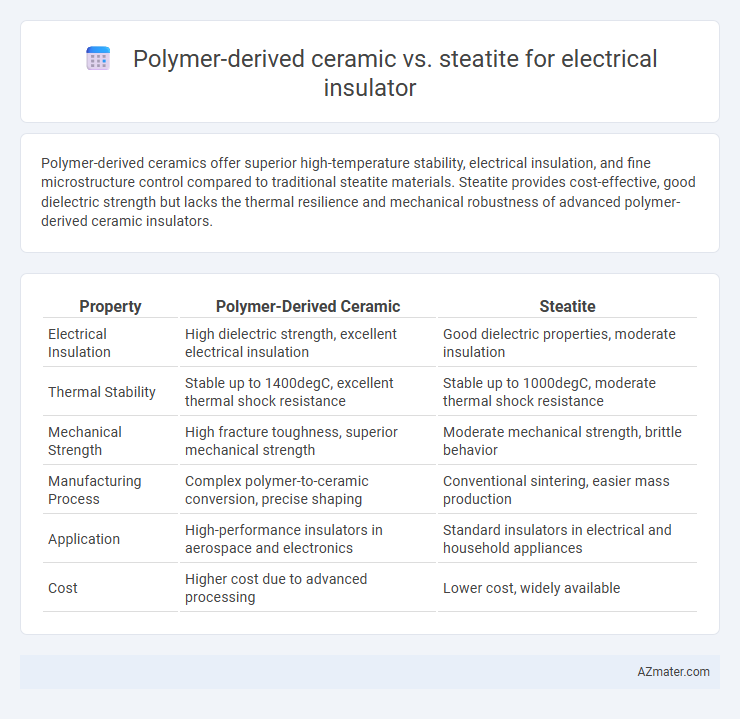Polymer-derived ceramics offer superior high-temperature stability, electrical insulation, and fine microstructure control compared to traditional steatite materials. Steatite provides cost-effective, good dielectric strength but lacks the thermal resilience and mechanical robustness of advanced polymer-derived ceramic insulators.
Table of Comparison
| Property | Polymer-Derived Ceramic | Steatite |
|---|---|---|
| Electrical Insulation | High dielectric strength, excellent electrical insulation | Good dielectric properties, moderate insulation |
| Thermal Stability | Stable up to 1400degC, excellent thermal shock resistance | Stable up to 1000degC, moderate thermal shock resistance |
| Mechanical Strength | High fracture toughness, superior mechanical strength | Moderate mechanical strength, brittle behavior |
| Manufacturing Process | Complex polymer-to-ceramic conversion, precise shaping | Conventional sintering, easier mass production |
| Application | High-performance insulators in aerospace and electronics | Standard insulators in electrical and household appliances |
| Cost | Higher cost due to advanced processing | Lower cost, widely available |
Introduction to Electrical Insulators
Electrical insulators such as polymer-derived ceramics and steatite are essential for preventing unwanted electrical conduction in high-voltage and electronic applications. Polymer-derived ceramics exhibit superior thermal stability, high dielectric strength, and excellent chemical resistance, making them ideal for advanced insulation needs. Steatite, a magnesium silicate ceramic, offers good electrical insulation properties at a lower cost but generally has lower mechanical strength and thermal tolerance compared to polymer-derived ceramics.
Overview of Polymer-Derived Ceramics
Polymer-derived ceramics (PDCs) offer superior electrical insulation properties characterized by high thermal stability, excellent dielectric strength, and low electrical conductivity compared to traditional materials like steatite. These ceramics are synthesized through the controlled pyrolysis of preceramic polymers, resulting in amorphous to nanocrystalline ceramics that maintain mechanical integrity at elevated temperatures exceeding 1000degC. The tunable composition and microstructure of PDCs enable enhanced performance in high-frequency and high-voltage electrical insulation applications, outperforming the commonly used steatite, which exhibits limitations in thermal shock resistance and dielectric constant stability.
Properties of Steatite Ceramic Insulators
Steatite ceramic insulators exhibit excellent dielectric strength, high mechanical hardness, and low dielectric loss, making them reliable for electrical insulation applications. Their superior thermal stability and resistance to moisture absorption enhance long-term performance in harsh environments. Compared to polymer-derived ceramics, steatite ceramics offer improved electrical insulating properties and greater dimensional stability under thermal stress.
Mechanical Strength Comparison
Polymer-derived ceramics exhibit superior mechanical strength compared to steatite, with higher fracture toughness and enhanced resistance to thermal shock. Steatite, while cost-effective and possessing good dielectric properties, tends to be more brittle and less durable under mechanical stress. Advanced polymer-derived ceramics are increasingly favored in applications requiring robust electrical insulators with reliable structural integrity.
Thermal Stability and Performance
Polymer-derived ceramics (PDCs) exhibit superior thermal stability compared to steatite, maintaining structural integrity at temperatures exceeding 1400degC, while steatite typically degrades above 1000degC. The intrinsic amorphous structure of PDCs ensures consistent electrical insulation and minimal dielectric loss under high thermal stress, outperforming steatite which may suffer from microcracks and decreased insulating properties. Enhanced thermal shock resistance and stable dielectric constant of PDCs make them ideal for advanced electrical insulator applications requiring prolonged exposure to extreme temperatures.
Electrical Insulation Capabilities
Polymer-derived ceramics exhibit superior electrical insulation capabilities compared to steatite due to their high dielectric strength and thermal stability, enabling reliable performance in high-voltage applications. Steatite, while cost-effective and offering good dielectric properties, typically has lower thermal resistance and dielectric breakdown strength, limiting its use in extreme electrical environments. The enhanced homogeneity and microstructure control in polymer-derived ceramics contribute to their exceptional insulating properties, making them ideal for advanced electronic components.
Chemical Resistance and Durability
Polymer-derived ceramics exhibit superior chemical resistance compared to steatite, withstanding corrosive environments due to their inert silicon-based matrix. They demonstrate enhanced durability under thermal cycling and mechanical stress, maintaining structural integrity where steatite may crack or degrade. Steatite, while cost-effective and electrically insulating, generally shows lower resistance to acidic and alkaline chemicals, reducing its lifespan in harsh industrial applications.
Manufacturing Process Differences
Polymer-derived ceramics (PDCs) involve a chemical synthesis route where preceramic polymers undergo pyrolysis, enabling precise control over microstructure and composition at relatively low temperatures. Steatite, a naturally occurring magnesium silicate, is processed through high-temperature sintering of powdered compacts, resulting in a dense ceramic with inherently stable dielectric properties. The manufacturing of PDCs allows for tailored electrical insulation characteristics due to their amorphous or nanocrystalline phases, while steatite's process relies on traditional ceramic shaping and firing techniques that yield consistent but less customizable insulative performance.
Cost and Economic Considerations
Polymer-derived ceramics typically exhibit higher production costs due to complex synthesis and high-temperature processing compared to steatite, which benefits from abundant raw materials and simpler manufacturing. Steatite's lower cost makes it economically favorable for large-scale electrical insulator applications where high thermal stability is less critical. However, polymer-derived ceramics offer enhanced performance and lifespan that can justify their investment in specialized, high-performance electrical insulation systems.
Application Suitability and Industry Adoption
Polymer-derived ceramics (PDCs) offer superior thermal stability and mechanical strength compared to steatite, making them highly suitable for high-temperature and high-frequency electrical insulation applications in aerospace and automotive industries. Steatite, with its excellent dielectric properties and cost-effectiveness, remains widely adopted in traditional electrical components such as capacitors, insulators, and substrates for power electronics. Industry adoption trends show PDCs gaining traction in advanced electronics requiring miniaturization and harsh environment resilience, whereas steatite continues to dominate bulk applications due to established manufacturing processes and lower material costs.

Infographic: Polymer-derived ceramic vs Steatite for Electrical insulator
 azmater.com
azmater.com